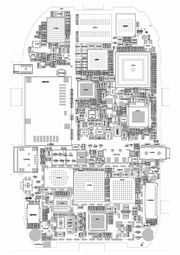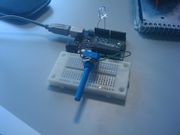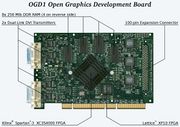Open hardware
From IT
Contents |
Introduction
Open Hardware is a part of the Open Source Culture and it is a movement that shares information about hardware components such as circuits diagrams or as in the last years the Hardware Description Language (HDL) code, bill of materials and printed circuit boards.
In my opinion it is better to call this movement Free (as in freedom) Hardware and the Open Source Culture, Free Culture.
This culture grew up thanks to the Internet: in fact, Internet allows people to share information around the world and collaborate also if they live in different countries or continents. A lot of Internet applications have been developed in order to facilitate communication, collaboration and sharing ideas: the most famous and widespread are the Email and the World Wide Web.
The philosophy of the Free Culture is mainly about software and the freedom of people to use technologies and have the control over them.
As our society grows more dependent on computers, the software we run is of critical importance to securing the future of a free society. Free software is about having control over the technology we use in our homes, schools and businesses, where computers work for our individual and communal benefit, not for proprietary software companies or governments who might seek to restrict and monitor us. Free Software Foundation
The Free Software is a movement created by Richard Matthew Stallman in 1983 with the purpose to develop a free Unix-like operating system. In 1985 R. M. Stallman founded the Free Software Foundation to promote the Free Software philosophy around the world, give a legal infrastructure to the movement and inform users about their digital rights.
The Free Software Definition includes four freedoms:
- The freedom to run the program, for any purpose (freedom 0).
- The freedom to study how the program works, and change it to make it do what you wish (freedom 1). Access to the source code is a precondition for this.
- The freedom to redistribute copies so you can help your neighbor (freedom 2).
- The freedom to distribute copies of your modified versions to others (freedom 3). By doing this you can give the whole community a chance to benefit from your changes. Access to the source code is a precondition for this.
Nowadays, a lot of famous software projects are Free Software: for instance, Apache Web Server is the most widespread Web Server and GNU Linux is the one of the most widespread operating systems for servers, mobile devices and desktop. The Free Software philosophy allows to create new pieces of software based on the existing one: for example, Google creates Android Operating System starting from GNU Linux and Apple creates Mac OS X starting from the Mach kernel and some parts of OpenBSD and NetBSD that are all free software.
The reasons
Behind the Free Culture there is the desire to have the full control, both on software and hardware, on own devices. The principles (freedoms) of Free Software can be applied also to others subjects such as hardware components, devices and cultural works. A lot of projects were born following this philosophy. There are three main reasons that drive the Free Hardware movement.
The first reason is that big hardware producers do not support GNU Linux with reliable drivers and also if developers are available to develop for free (as a beer) new free (as in freedom) drivers they can not access to technical information about devices because producers do not share this type of information. In this case, having free peripherals with all technical information freely available on the internet is the best solution to the problem.
The second reason is the Next-Generation Secure Computing Base, formerly known as Palladium, a software architecture created by Microsoft that relies on hardware created by the Trusting Computing Group. This architecture was created to secure devices and software in order to prevent virus attacks and other security problems, but it is also a way for companies to control which contents can be used in a device. Against Palladium, and in general, against any type of Digital Right Management mechanism, the Free Software Foundation launch a campaign called Defective By Design with the goal to inform users about the risks connected to devices that are built using Palladium architecture and give the advise to buy DRM free devices.Digital Restrictions Management (DRM) robs us of control over the technology we use and the culture we live in. DRM and the Digital Millennium Copyright Act (DMCA) can make it illegal to share an article, back-up your kids' favorite DVD, or move your music from one player to another. Since DRM is inherently incompatible with free software, it also excludes free software users from equal participation in culture. (Free Software Foundation Campaigns)
The third reason is about people and their need to share their ideas. This reason is not strictly related to the Free Culture movement or other philosophical thoughts, but it is strictly related to the nature of human beings: they want, or better, they need to share experiences, ideas and projects with other human beings.
The Free Hardware movement is a response to those problems and needs: creating free components and devices that can not be controlled by companies and that do not use the Palladium architecture, share ideas and work together to improve everyday life. Only in this way it is possible to have the full control of own devices, to use them in the way we want and to be free human beings.
Case studies
The Free Hardware movement counts a lot of projects. In my opinion, the most interesting projects are:
- Openmoko
- OpenSPARC
- Arduino
- The Open Graphics Project
- Other projects.
Openmoko
The Openmoko project was created in Taiwan by a small group of people with the goal to create a free smartphone easy to use, easy to customize and easy to hack. The result of this project is the FreeRunner.The FreeRunner mobile phone was specifically designed with ease of developer access from the very start. Our goal was to "Free Your Phone". Hardware components were selected based on the requirement of publicly available documentation. A debug port with complete access to all the low-level hardware was added, along with interesting signals at easily solderable contact pads so hardware hackers can have fun. Even an extra memory chip was added with an additional operating system. This way, if you overwrite your main system, you can boot into an emergency recovery mode. (Openmoko FreeRunner Official Page)
The FreeRunner design process used the social design to create the device: all schematics and all information about the design can be freely downloaded from the Openmoko wiki and everyone is invited to participate to the community thus in the social design process.
Good design and social design can be one and the same thing. Design influences and shapes our environment, our experiences, our relationships, even as it enhances economic growth. We acknowledge our social responsibility. By carefully selecting the materials we use, we make more ecologically conscious products. We strive to create real change in the world through good socially conscious design. (Openmoko Social Design)
OpenSPARC (Scalable Processor ARChitecture)
Sun Microsystems is a big IT company, recently acquired by Oracle, that created Solaris OS, SPARC processors, Java, NetBeans, OpenOffice.org and bought a lot of famous softwares such as StarOffice, Virtual Box and MySQL.In March 2006, the complete design of Sun Microsystems' UltraSPARC T1 microprocessor was released-in open-source form, it was named OpenSPARC T1. In early 2008, its successor, OpenSPARC T2, was also released in open-source form. These were the first (and still only) 64-bit microprocessors ever open-sourced. They were also the first (and still only) CMT (chip multithreaded) microprocessors ever open-sourced. Both designs are freely available from the OpenSPARC website to anyone. (About OpenSPARC)
The difference between OpenSPARC project and Openmoko project is that in the second one the community was involved into the design phase from the beginning while in the first one community was involved after Sun Microsystems published the information about the processor.
Arduino
Arduino is a project founded by Massimo Banzi and David Cuartilles in 2005.Arduino is an open-source electronics prototyping platform based on flexible, easy-to-use hardware and software. It's intended for artists, designers, hobbyists, and anyone interested in creating interactive objects or environments.
With Arduino it is possible to build fully working prototypes, putting together various hardware components and developing the software controllers through an "easy to use" programming language that is a subset of C language. During a workshop at SUPSI in Lugano, Massimo Banzi taught the basics of Arduino and together we developed a prototype of LED controller: the LED changed his light intensity according to the movement of a potentiometer.
The piece of code that make possible the functionality is shown below:
int val = 0;
void setup()
{
Serial.begin(9600); // debug
pinMode(10, OUTPUT);
}
void loop()
{
val = analogRead(0); // read data from pin A0
val = map(val, 0, 1023, 0, 255);
analogWrite(10, val);
Serial.println(val); // debug
delay(100);
}
As for Openmoko and OpenSPARC, all the design schemas of Arduino are freely available to the download and people can derivate other hardware components starting from the Arduino components to produce commercial parts.
Open-source hardware shares much of the principles and approach of free and open-source software. In particular, we believe that people should be able to study our hardware to understand how it works, make changes to it, and share those changes. To facilitate this, we release all of the original design files (Eagle CAD) for the Arduino hardware. These files are licensed under a Creative Commons Attribution Share-Alike license, which allows for both personal and commercial derivative works, as long as they credit Arduino and release their designs under the same license. The Arduino software is also open-source. The source code for the Java environment is released under the GPL and the C/C++ microcontroller libraries are under the LGPL. (From Arduino's FAQ)
Interesting creations made with Arduino are: Football Hero by Kasabian, Thing-O-Matic 3D Printer by MakerBot Industries and C60 Redux by Ideo.
The Open Graphics Project
The Open Graphics Project aims to create graphics cards with Free-licensed specifications and Free Software drivers.We believe you have the right to own your computer and get the graphics you deserve. You paid for it. You should be free to innovate and to run the system you choose.
Currently your graphics are often restricted. Unless you are bigger than Dell they are uninterested in what you want to do. You are enslaved to their bugs and restrictions. Yet these restrictions are what a company in another part of the world arbitrarily chose to apply to you. Want to change the world? You will need permission first.
The Open Graphics Project believes innovation and freedom is important.
We believe your freedoms' include the right to own your computer and we welcome innovation. We have a reliable card with open specifications that you can tinker with. You can read our bios and change it. You can experiment with a working hardware design. The Drivers are open. Yes, we invite you to help improve them. You can alter them to suit your needs. Want to help us change the world? We are changing it now... (The Open Graphics Project)
The Open Graphic Development board 1 (OGD1) is the first result of this project. The OGD1 is a PCI graphic card, mainly designed for 3D applications that should have performances similar to an ATI Radeon 7000 (this is the project's target).
Other projects
Other interesting resources related to the Free Hardware movement are a lot of websites where people share their ideas, designs or instructions to self build every kind of devices. Two of those websites are:
In addition, there is a framework called openFrameworks that allows to fast prototype software using a common PC or Mac and devices using micro-controllers such as Arduino.
Conclusion
The Free Hardware movement, but in general the Free Culture related to the new technologies, is growing up day by day. The involvement of people in the design process, the availability of all the information about technological products are the basic for development, research and study of new solutions that fit perfectly the need of digital everyday life, preserving the freedom of people. Of course, these information can be used only by technicians, but it is important that all the people, not only technicians, that use a technological artifact are aware about risks connected to devices or software that are impossible to study because companies do not share information about them.
A very recent example (8 January 2011) about the control that companies can have on our devices is the case of VLC player. Apple Inc. refuses to publish the VLC application for iOS devices (iPhone, iPod Touch, iPad) on iTunes App Store. This means that is not possible to install VLC player on Apple mobile devices also if we are the owners of the device. The reason behind this refuse by Apple is that GNU General Public License (GPL) is not compatible with Apple DRM policy.
Another alarming news comes from the CES 2011 in Las Vegas: the Digital Entertainment Content Ecosystem (DECE) consortium is ready to spread the universal DRM. Each US family will be provided by 6 accounts that can be used to authenticate a content legally purchased by one of the DECE resellers and transfer this content (e.g. a movie) from a device to another. A US family can have maximum 12 devices and these devices, of course, must support the DECE DRM otherwise it is impossible to play the content.
As the Free Software Foundation told, our lives are more and more influenced by technologies and if we want to be free, we must know which are the risks. If only a small group of companies know (control) technologies then people will become slaves of these companies. The Free Culture is a way to inform people, to share knowledge and to improve our life and the life of neighbor.





